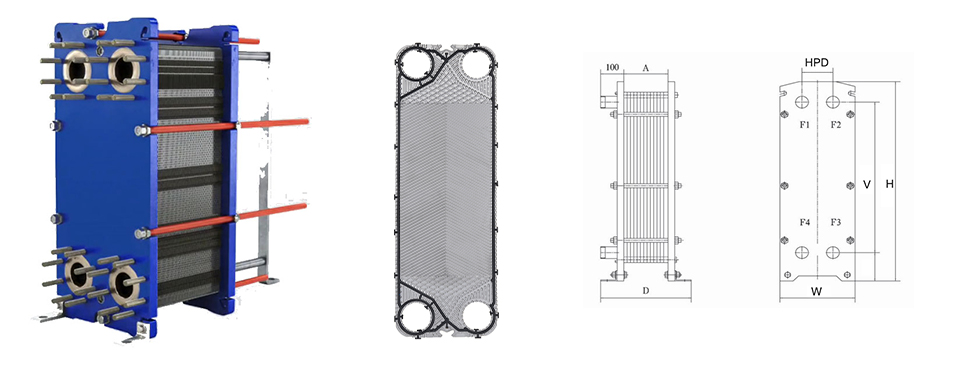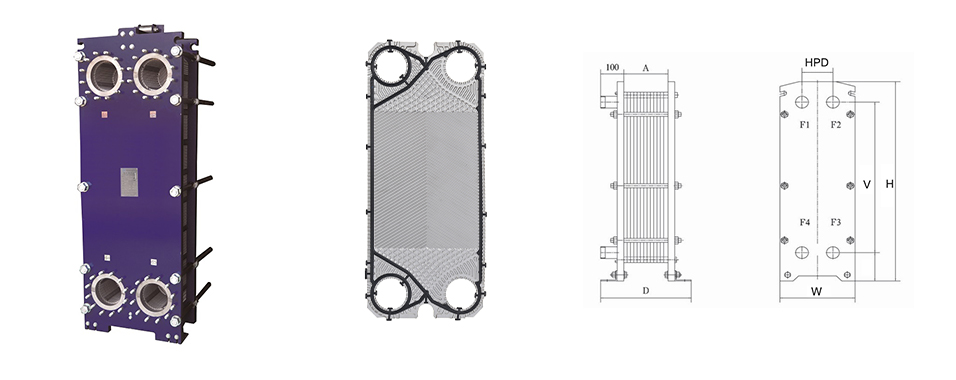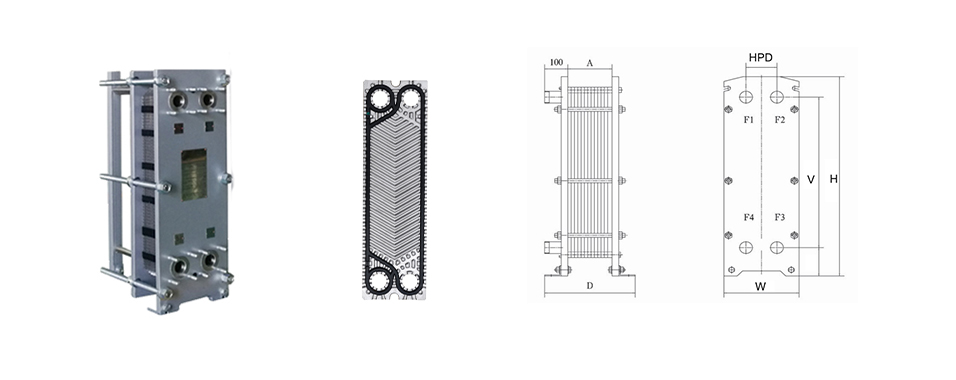How to Clean Gasketed Plate Heat Exchanger
Just like a car or a computer, a gasketed plate heat exchanger need regular maintenance to keep running at peak performance. Fortunately, plate heat exchangers (PHE) are generally easier to maintain than other types of heat exchangers, and problems tend to be easier to diagnose.
In the absence of regularly scheduled maintenance, a PHE’s efficiency naturally declines. The simple reason for this is plate fouling – as matter builds up in the grooves of a plate, the heat transfer capacity of that plate diminishes (because the fouling is less thermally conductive than the plate itself). The more scaling there is on a plate, the faster it continues to foul, so it’s important to catch the issue early to avoid extended downtime and excessive maintenance costs.
While less likely, other parts of a plate heat exchanger can fail as well. It’s important to visually inspect the gaskets, frame and bars whenever you open up the heat exchanger for any kind of maintenance. A habit of cursory visual examinations can save a lot of time and money in the long run.
Records
To ensure you’re keeping your plate heat exchanger properly maintained, you should keep basic records. Those should include the make and model number, what kind of maintenance you’ve already performed and when you performed it, available spare parts in your inventory, and the number of plates and gaskets in the unit. You should also know the dimensions of the plate pack as specified by the manufacturer (PHE’s aren’t tightened to a torque specification, but rather to the width of the plate pack) so you can periodically check it for tightness, and return it to its original state after scheduled maintenance. When you tighten the PHE, it’s also a good time to lubricate the carrying and guide bars to make opening the PHE easier next time.
Scheduled Maintenance
The most important kind of maintenance is the regular, scheduled maintenance that you do even if the unit appears to be working just fine. This is the equivalent of changing your car’s oil before the Check Engine light comes on, or going to the dentist even if you don’t have cavities (that is to say, you should do it!). Perform this kind of maintenance at least once every six months.
As mentioned above, regular visual examinations are important – make sure the plate pack is tightened to specification, the carrying and guide bars are lubricated, and the gaskets appear undamaged. Then, check your pressure gauges at each end of the plate heat exchanger to make sure the pressure drop is within expected limits.
If, after the above regular maintenance tasks are performed, the pressure drop is excessive, then there is likely a fouling issue and you’ll have to do unscheduled maintenance, which means downtime. It’s also possible that the problem lies somewhere else in your process. Make sure your pipes are in good shape, and all your pumps are doing their jobs. If everything else seems to be in working order, it’s time to clean your PHE. Request one of our service technicians to get your unit back up and running or perform preventative maintenance to minimize downtime.
Clean-In-Place
Periodic cleaning is the most effective form of maintenance and should comprise the bulk of your maintenance efforts. Most PHE’s can be maintained with a clean-in-place (CIP) process, where you don’t have to open the plate pack. The biggest goal of cleaning is to flush out the various kinds of debris that collect in a PHE over time, which will vary depending on your process.
To clean your plate heat exchanger, first drain both sides and isolate it from your system fluid (generally done with isolation valves). Then, flush water through both sides until it runs clear. For best results, you should flush the fluids counter to the direction that they run in operation. If a lot of debris comes out, then you’re in good shape! If, however, the excessive pressure drop persists after putting the PHE back in service, or if you didn’t see very much debris, then you’ll need something more aggressive than water.
The next step is to pass a cleaning agent through the PHE with a circular pump and a solution tank. The agent itself will be dictated by your particular process, but your PHE manufacturer can help you learn about the cleaning process in more detail if you’re unsure. In particular, you must ensure that the cleaning agent is compatible with the plates and gaskets of your PHE. Chloride, for example, will almost surely corrode the plates if they’re made of stainless steel (which most are). After running the cleaning agent through your PHE, flush it with water again until both sides discharge clear. If, after putting the PHE back in service, it still runs under capacity, then you’ll need to open up the plate pack and clean it manually.
Manual Cleaning
To clean a plate heat exchanger manually, open the plate pack according to the manufacturer’s instructions. It’s preferable to clean the plates without taking them out of the frame, which is one of the reasons why it’s recommended to install a PHE where there is plenty of space to maneuver around it.
Next, manually apply the cleaning agent to each plate to loosen any debris that may have accumulated. Then, rinse the agent off with a soft bristle brush and high-pressure washer. Wire brushes or metal pads are discouraged because they may score the plates. Be careful that you don’t hit the gaskets with the washer directly, as the high pressure may loosen or dislodge them. After the plates are completely rinsed, reassemble the PHE and put it back into service – everything should be good as new!
While this cleaning regimen is an involved process, it should still take no longer than 24 hours. Scheduled maintenance will take far less time, and will save your maintenance crew time and money.
VHX has full range of plate and gasket for PHE maintaining, we have more than 200 models produced to fulfill different kinds of demands, if you have any heat exchanger related issues please do not hesitate to contact us for help.
In the absence of regularly scheduled maintenance, a PHE’s efficiency naturally declines. The simple reason for this is plate fouling – as matter builds up in the grooves of a plate, the heat transfer capacity of that plate diminishes (because the fouling is less thermally conductive than the plate itself). The more scaling there is on a plate, the faster it continues to foul, so it’s important to catch the issue early to avoid extended downtime and excessive maintenance costs.
While less likely, other parts of a plate heat exchanger can fail as well. It’s important to visually inspect the gaskets, frame and bars whenever you open up the heat exchanger for any kind of maintenance. A habit of cursory visual examinations can save a lot of time and money in the long run.
Records
To ensure you’re keeping your plate heat exchanger properly maintained, you should keep basic records. Those should include the make and model number, what kind of maintenance you’ve already performed and when you performed it, available spare parts in your inventory, and the number of plates and gaskets in the unit. You should also know the dimensions of the plate pack as specified by the manufacturer (PHE’s aren’t tightened to a torque specification, but rather to the width of the plate pack) so you can periodically check it for tightness, and return it to its original state after scheduled maintenance. When you tighten the PHE, it’s also a good time to lubricate the carrying and guide bars to make opening the PHE easier next time.
Scheduled Maintenance
The most important kind of maintenance is the regular, scheduled maintenance that you do even if the unit appears to be working just fine. This is the equivalent of changing your car’s oil before the Check Engine light comes on, or going to the dentist even if you don’t have cavities (that is to say, you should do it!). Perform this kind of maintenance at least once every six months.
As mentioned above, regular visual examinations are important – make sure the plate pack is tightened to specification, the carrying and guide bars are lubricated, and the gaskets appear undamaged. Then, check your pressure gauges at each end of the plate heat exchanger to make sure the pressure drop is within expected limits.
If, after the above regular maintenance tasks are performed, the pressure drop is excessive, then there is likely a fouling issue and you’ll have to do unscheduled maintenance, which means downtime. It’s also possible that the problem lies somewhere else in your process. Make sure your pipes are in good shape, and all your pumps are doing their jobs. If everything else seems to be in working order, it’s time to clean your PHE. Request one of our service technicians to get your unit back up and running or perform preventative maintenance to minimize downtime.
Clean-In-Place
Periodic cleaning is the most effective form of maintenance and should comprise the bulk of your maintenance efforts. Most PHE’s can be maintained with a clean-in-place (CIP) process, where you don’t have to open the plate pack. The biggest goal of cleaning is to flush out the various kinds of debris that collect in a PHE over time, which will vary depending on your process.
To clean your plate heat exchanger, first drain both sides and isolate it from your system fluid (generally done with isolation valves). Then, flush water through both sides until it runs clear. For best results, you should flush the fluids counter to the direction that they run in operation. If a lot of debris comes out, then you’re in good shape! If, however, the excessive pressure drop persists after putting the PHE back in service, or if you didn’t see very much debris, then you’ll need something more aggressive than water.
The next step is to pass a cleaning agent through the PHE with a circular pump and a solution tank. The agent itself will be dictated by your particular process, but your PHE manufacturer can help you learn about the cleaning process in more detail if you’re unsure. In particular, you must ensure that the cleaning agent is compatible with the plates and gaskets of your PHE. Chloride, for example, will almost surely corrode the plates if they’re made of stainless steel (which most are). After running the cleaning agent through your PHE, flush it with water again until both sides discharge clear. If, after putting the PHE back in service, it still runs under capacity, then you’ll need to open up the plate pack and clean it manually.
Manual Cleaning
To clean a plate heat exchanger manually, open the plate pack according to the manufacturer’s instructions. It’s preferable to clean the plates without taking them out of the frame, which is one of the reasons why it’s recommended to install a PHE where there is plenty of space to maneuver around it.
Next, manually apply the cleaning agent to each plate to loosen any debris that may have accumulated. Then, rinse the agent off with a soft bristle brush and high-pressure washer. Wire brushes or metal pads are discouraged because they may score the plates. Be careful that you don’t hit the gaskets with the washer directly, as the high pressure may loosen or dislodge them. After the plates are completely rinsed, reassemble the PHE and put it back into service – everything should be good as new!
While this cleaning regimen is an involved process, it should still take no longer than 24 hours. Scheduled maintenance will take far less time, and will save your maintenance crew time and money.
VHX has full range of plate and gasket for PHE maintaining, we have more than 200 models produced to fulfill different kinds of demands, if you have any heat exchanger related issues please do not hesitate to contact us for help.








